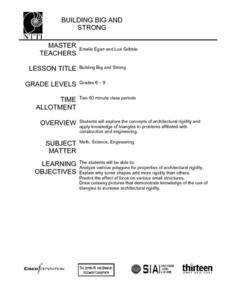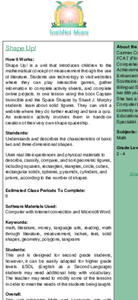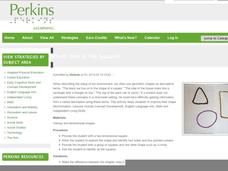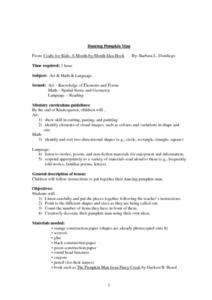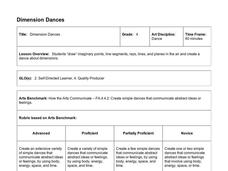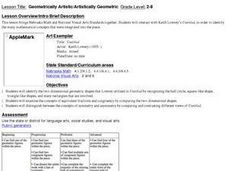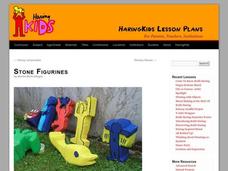Curated OER
Three-Dimensional Ceramic Sculptural Forms Inspired by the Paintings of Wassily Kandinsky
Pupils analyze / deconstruct elements of design used in Wassily Kandinsky's paintings in order to synthesize the elements into a three-dimensional form. Works may be functional or non-functional.
Curated OER
O Greek Shape! O Fair Pose!
Young scholars analyze the black-figure painting style of ancient Greece and its influence on Neoclassical artists during the 18th century, as seen in drawing, painting and silhouettes, or shadow portraits. In this ancient art...
Curated OER
Inuit Sculpture
Kids in grade four through eight research Inuit artists and art styles. After a critical look at Inuit sculpture, they use those forms for inspiration as they create one of their own. They practice using the subtractive method of...
Curated OER
4-H Line and Design: Intermediate Activity Page
In this 4-H line and design activity, students will complete a variety of design related activities. Students will use colored pencils to draw in the missing pieces of artistic photographs. Next, they will find and circle 6 art words in...
Curated OER
2-D and 3-D Presents at Pedro's Party
Fifth graders draw 2-D and 3-D shapes. They sketch and label geometric figures with correct terminology, then explore parallel and perpendicular lines. Pupils sort and classify shapes drawn.
Curated OER
Parallel and Perpendicular Lines
Learners study parallel and perpendicular lines. For this parallel and perpendicular lesson, pupils explore 2-D shapes and determine if the sides are parallel or perpendicular.
Curated OER
Building Big and Strong
Middle and high schoolers explore the concepts of architectural rigidity. They analyze a variety of polygons, and explain why some shapes add more strength to structures than others. The PBS video, "Building Big," is utilized in this plan.
Curated OER
Embracing Embossing
Students explore the technique of embossing through the use of aluminium foil and a three dimensional collage. For this embossing lesson, students create a sentence with the letters of the word stamp. Students discuss a...
Curated OER
Dimension in Art
Third graders consider space and the techniques artists use to create three-dimensionality within a painting or drawing. They examine works by Millet, Bruegel and Demuth and then create original drawings that explore the effects of...
Curated OER
Shape Up!
Students investigate measurement through the use of literature through this series of lessons.
Curated OER
Space Shapes
Young scholars read "Captain Invincible and the Space Shapes" by Stuart Murphy and view a PowerPoint presentation on shapes. They identify shapes presented in the book and then identify shapes found in their classroom.
Perkins School for the Blind
Which One is the Square?
Children who are blind need to constantly be engaged in building conceptual understandings of the world around them. This activity will help them grasp the concept of shape, identify shapes, and consider shapes as they are used to...
Curated OER
Zany Wire Sculpture
Young artists create a freestanding 3-dimensional sculpture using wire and modeled "clay" pieces. This immensely creative and engaging lesson should get your kids excited, because the medium is unusual to work with. Everything you need...
Curated OER
Making Twisteez Masks
Young artists build a three-dimensional form with Twisteez Wire on a stationary screen base. They can paint the base if they wish. The results of this art project are spectacular, but be warned that the materials needed are not easy to...
Curated OER
Dancing Pumpkin Man
Students listen carefully and put pieces together following the teacher's instructions. They point to the different shapes and sizes as they are being called out and count the number of items they have in front of them. They decorate...
National Gallery of Canada
My Scene
Acquaint your class with line, color, shape, and texture through a study of artwork and an art activity. The resource includes images and information to share with your class before sending individuals off to sketch and paint...
Curated OER
Sports Lesson Plan
Have your class participate in a variety of sports and craft activities using this resource. With sports as the theme, learners work on art projects. Students create soccer ball prints, a three dimensional football, and a sports collage.
Hawaiʻi State Department of Education
Dimension Dances
Use dance to help learners conceptualize line segments, rays, lines, and planes. They choreograph dances that show dimensional space. Dancers start by pondering space, point, and lines as the teacher draws them in the air. Each...
Curated OER
Ellsworth Kelly
Students examine and discuss artwork by the artist Ellsworth Kelly. They create an abstract picture of two-dimensional geometric shapes using Kid Pix software based on a photograph taken by the student.
Curated OER
Arti'stick Mobile
Learners examine works of stained glass in one dimensional art form then adapt it a three dimensional transparent mobile. They create their mobile using patterns of shapes and simple images from computer line art, printed art books or...
Curated OER
Geometrically Artistic/Artistically Geomtric
Students identify the two-dimensional geometric shapes Lowrey utilized in the painting Untitled. Students compare the two-dimensional shapes in terms of equivalent fractions, congruency, symmetry and asymmetry. Students create their own...
Curated OER
Stone Figurines
Students analyze visual arts by examining images on the Internet. In this figurine lesson, students research Keith Haring's artwork on the web and identify his body movement artistic style. Students utilize soft stones, carving...
Hawaiʻi State Department of Education
Symmetrical Objects
In order to better understand how to locate a plane of symmetry in 3-dimensional objects, learners create a dance. The class reviews dance and math symmetry, then they practice making symmetrical shapes and movements with a partner....
K12 Reader
3-D: It’s Not Just for Movies
This two-part reading comprehension exercise asks kids to read a short passage about cubes, rectangular prisms, spheres and pyramids, and then to respond to a series of questions about the article.






